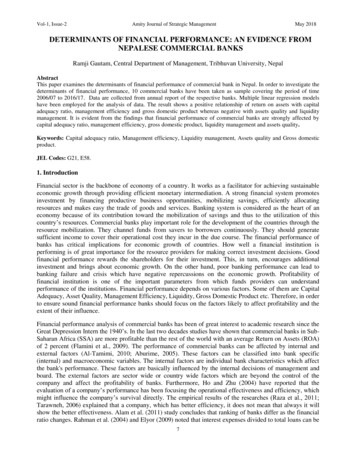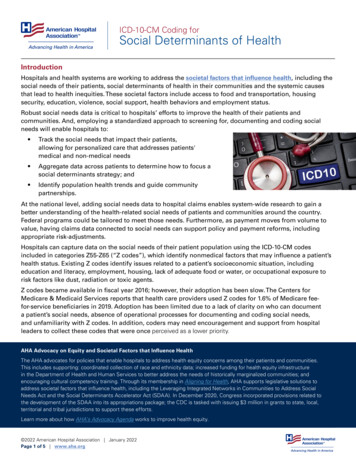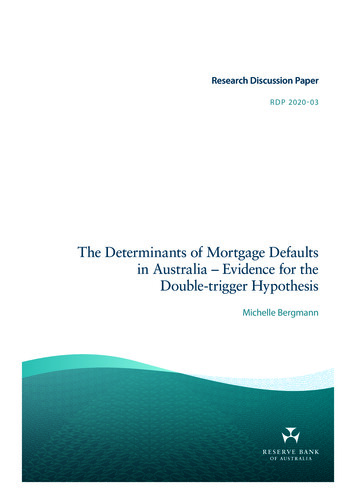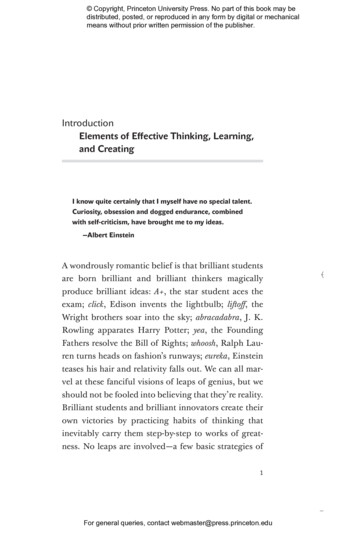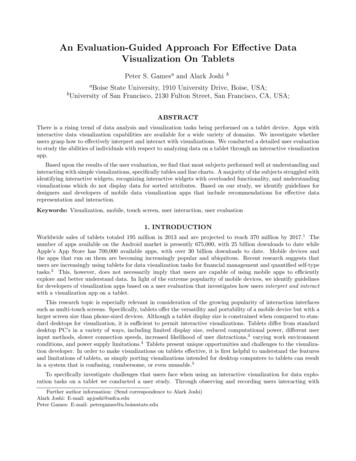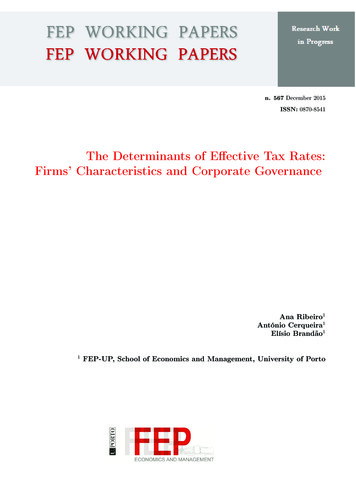
Transcription
n. 567 December 2015ISSN: 0870-8541The Determinants of E ective Tax Rates:Firms' Characteristics and Corporate GovernanceAna Ribeiro11António Cerqueira1Elísio Brandão1FEP-UP, School of Economics and Management, University of Porto
The Determinants of Effective Tax Rates: Firms’ Characteristics andCorporate GovernanceAna Ribeiro (a)University of Porto, School of Economics and ManagementAntónio Cerqueira (b)University of Porto, School of Economics and ManagementElísio Brandão (c)University of Porto, School of Economics and ManagementContacts:(a) ana.isabel.mribeiro@gmail.com(b) amelo@fep.up.pt(c) ebrandao@fep.up.pt1
AbstractInvestors, managers and shareholders benefit from the study of what influences anddetermines corporate effective tax rates (ETRs) as this analysis may contribute to potential taxsavings. Moreover, standard setters, regulators and policy makers have a crucial interest inidentifying the main factors driving corporate taxes. Therefore, the purpose of our investigationand contribution is twofold. Firstly, we provide evidence of how ETRs are determined by firms’financial and operational characteristics. Secondly, our objective is to show the role ofCorporate Governance attributes in explaining ETRs. As the literature about this topic usingnon-US firms is not abundant, to address these questions we select a sample of 704 nonfinancial firms listed on the London Stock Exchange between 2010 and 2013. We estimate oureconometric model by using GLS cross-section weights. Our results show that larger and moreprofitable firms have higher ETRs. On the contrary, capital intensity, leverage and R&Dexpenses have a negative impact on ETRs. Regarding ownership structure and boardcomposition, our findings reveal that managerial ownership contributes to lower ETRs. On theother hand, more independent firms from controlling shareholders exhibit higher ETRs.Moreover, a larger number of board members and non-executive directors results in higherETRs.Keywords: Effective tax rate; Corporate Finance; Corporate GovernanceJEL Classification: G30, H202
1. IntroductionThis paper aims at giving a contribution to the extant literature on the determinants ofeffective tax rates (ETRs). Our particular focus is on the impact of a firm’s financial andoperational specific characteristics and Corporate Governance mechanisms on ETRs.Corporate tax rate is an instrument of fiscal policies. Ever more the choice andestablishment of the statutory tax rate is on the main agenda of governments. It is well knownthat taxes are an important source of revenue in order to states develop their public policies.However, the willingness to increase statutory taxes in order to satisfy that purpose has beensomewhat constrained by other important aspects such as the relevance of corporate taxation tothe attractiveness of foreign investment. Therefore, investigations concerning the analysis ofwhich factors may influence the taxes paid by firms are useful for regulators and policy makersand contribute to the definition of domestic tax systems.If taxes are a significant element for macroeconomic policies they are no less importantfor firms’ strategic decisions. As well documented by Graham (2003) effective tax rates canaffect corporate decision making and other related aspects such as capital structure, payoutpolicy and risk management. Taxes are ever more viewed as an enhancing component of bottomline firms’ performance. Robinson et al. (2010) show that evaluate a firm’s tax department as a“profit centre” is associated with lower effective tax rates than if it was categorized as a “costcentre”. Therefore, any reduction of taxes paid contributes to an increase of earnings disclosedin the financial statements. Considering that the main purpose of firms’ activity should becreating value to shareholders, actions to minimize the tax burden are in line with that objective.According to this perspective, we examine whether firms’ specific characteristics aredeterminants of effective tax rates. We follow a similar approach to the one used by Richardsonand Lanis (2007) and, more recently, by Kraft (2014) to estimate the impact of firms’characteristics on ETRs. Many studies have paid attention to the influence of firms’ specificcharacteristics on ETRs (Gupta and Newberry, 1997; Desai and Dharmapala, 2006; Dyreng etal., 2008; Hanlon et al., 2010; Minick and Noga, 2010; Armstrong et al. 2012). Followingprevious literature we are interested in the influence of size, profitability, capital structure andasset mix composition on effective tax rates. We expect those variables to be related to firms’tax expense. Tax expense or tax income is defined in the IAS 12 (IASB, 2010) as “the aggregateamount included in the determination of profit or loss for the period in respect of current taxand deferred tax”. To compute effective tax rate, in the first instance, we divide tax income to3
pre-tax income. As a second measure of effective tax rate we use the ratio of tax expense tocash flow from operations (Richardson and Lanis, 2007).Apart from financial and operational performance as determinants of ETRs, the secondpart of our investigation focus on how Corporate Governance mechanisms influence effectivetax rates, specifically, we are interested in the analysis of ownership structure and board ofdirectors’ composition. Minick and Noga (2010) consider Corporate Governance mechanismsas explanatory variables of ETRs. They emphasize that staggered boards are associated withhigher effective tax rates. Following their approach we include in our regressions the influenceof board of directors’ composition and ownership structure. The main reason to consider thoseCorporate Governance characteristics is related to the agency problem. Decisions regarding taxmanagement with the objective of reducing effective tax rates have impact on firms’performance and, hence, contribute to maximize firm value which will benefit shareholders.Nevertheless, these decisions are to some extent dependent on managers’ discretion. Thereforemanagers may not act in the best shareholders’ interests which give potential to the presence ofagency costs (Jensen and Meckling, 1976). Ownership structure, mainly, managerialownership, is an important instrument to reduce that conflict. Jensen and Meckling (1976)suggest a positive association between managerial ownership and Corporate Governance.Florackis (2008) argues that an adequate level of managerial ownership reduces managers’incentives for perk consumption and engagement in non-maximizing activities. On the otherhand, if there is a high level of managerial ownership, managers have more opportunities toextract own benefits and to intensify the entrenchment effect. As pointed out by Desai andDharmapala (2006) the alignment of shareholders and managers interests through promotion oftax avoidance activities might not be that valuable to shareholders as expected. Due to thedifficulty of measuring the actual effects of tax avoidance activities, these activities cansmokescreen managers’ rent extraction behaviour. Therefore, shareholders’ willingness topromote tax avoidance activities is weakened by that fact. The existence of controllingshareholders, due to a high stake of shares held, may also influence shareholders’ willingnessto monitor managers’ decisions. Shareholders with higher participations will benefit more fromhigher earnings; therefore they have incentives to promote activities that contribute to thereduction of the effective tax rate (Florackis, 2008). On the other side, shareholders with ahigher participation will be more exposed to potential penalties and reputational damages thatmay occur as a consequence of activities aiming the reduction of ETRs (Chen et al., 2010).4
When we talk about the duality managers – shareholders we must include a third partyin this relationship. The board of directors is an important element to characterize firms’Corporate Governance. It should develop a policy based governance system and a guidelines’framework to conduct management actions. As a result, one of its responsibilities is monitoringmanagers (Adams et al., 2010). Additionally, the board of directors also chooses its owncomposition and officers. These functions can contribute to support and promote shareholdersrights and interests, on the one hand, or to facilitate managerial opportunism depending uponthe level of managers’ power, on the other hand. As a result, we must also consider the size andcomposition of board of directors as valuable characteristics to help to mitigate the agencyproblem.In order to investigate the determinants of effective tax rates described above, morespecifically firms’ financial and operational characteristics and Corporate Governanceattributes, we select a sample of non-financial firms listed on the London Stock Exchange. Oursample is constituted by 704 firms which we analyse over the period 2010-2013. With thepurpose of studying the determinants of effective tax rates we estimate four regressions. Thefirst two equations follow the model used by Richardson and Lanis (2007) and Kraft (2014);the last two equations introduce Corporate Governance mechanisms as in the Minick and Noga(2010) model. With the inclusion of Corporate Governance attributes we obtain a morecomplete model in order to test what affects effective tax rates. To estimate our regressions weuse Generalized Least Squares (GLS) cross-section weights with time fixed effects through theinclusion of year dummy variables.Our results show that firms’ specific characteristics have influence on ETRs. Larger andmore profitable firms have higher ETRs. Unlike size and profitability, there is a negativerelation between leverage, capital intensity, research and development expenses and effectivetax rates. These findings are consistent with those in previous researches. Concerning CorporateGovernance mechanisms, we find evidence supporting the influence of ownershipconcentration and board of directors’ composition on ETRs. Insider ownership is associatedwith lower effective tax rates. On the contrary, firms with a less concentrated ownershipstructure evidence higher ETRs. Regarding board of directors’ composition, boards with ahigher dimension have higher effective tax rates. As well, the presence of non-executivedirectors contributes to higher effective tax rates.5
Our paper contributes to the extant literature on effective tax rates both at the theoreticaland the empirical level. Our first contribution to this field of investigation regards the samplewe use. To our knowledge, the literature related to the study of effective tax rates which usesfirms listed on the London Stock Exchange is scarce. The majority of the studies aboutCorporate Governance and ETRs are largely based on USA firms. Secondly, by consideringfirms listed on LSE and by analysing a more recent period than other studies, we observe howand which financial and operational indicators, can impact ETRs. These determinants are alsoa consequence of managers’ decisions. By taking this into consideration, our paper contributesto the extant literature on the influence of firms’ specific characteristics on ETRs. A thirdcontribution results from the introduction of Corporate Governance mechanisms in theexplanation of effective tax rates. There is a growing body of literature concerned about theinfluence of Corporate Governance on ETRs. This is mainly a consequence of agency problemsand its impacts on firms’ performance (Jensen and Meckling, 1976). Managers may not act inthe best interest of shareholders and, consequently, they can make decisions which are not valuemaximizing. Therefore, we must introduce in our analysis Corporate Governance attributes asthese mechanisms help to control and monitor managers’ actions. To the best of our knowledge,our Corporate Governance set of variables is unique. We include in our model two differentdimensions related to Corporate Governance attributes, we include variables to measureownership structure and the board of directors’ composition. We use a set of four variables totest the influence of Corporate Governance on ETRs. A fourth contribution of our investigationis related to the measurement of our Corporate Governance variables. Our variables aremeasured year by year. The accuracy about the measurement of these variables constitutesanother important contribution of our study as the majority of other studies using CorporateGovernance usually consider these variables as constant over short periods of time. To achievethis precision we needed to contact the provider of Amadeus Database as information ofCorporate Governance for past years is not displayed on the information available to end users.Still concerning the variables of Corporate Governance, we add a fifth contribution as we usea variable to control firms’ independence in relation to blocking shareholders by consideringparticipations higher than 25%. According to our knowledge, the most common variablesrelated to ownership concentration define lower limits of participation to categorize firms asindependent or not. In light of the above, we contribute to the previous literature bysimultaneously observing the impact of firms’ characteristics and Corporate Governancemechanisms on ETR.6
The remainder of this paper is organized as follows. Section 2 presents a brief review ofthe extant literature related with the influence of firms’ financial characteristics and CorporateGovernance attributes on effective tax rates. In this section we develop our set of hypothesis.Section 3 describes the variables and the sample selection process. The methodology used inthis paper and univariate results are evidenced on Section 4. Results regarding our hypothesesare exhibited on Section 5. To conclude, Section 6, presents a summary of this paper.7
2. Literature Review and Hypotheses DevelopmentCorporate taxation has becoming increasingly relevant to corporate financial decisions.Graham (2003) presents a set of corporate decisions that are influenced by taxes. As taxationrepresents a cost to a firm it necessarily affects its performance. Therefore, there has been agrowing concern to find ways to reduce the firms’ tax burden. Hence, a large body of literaturehas been developed to investigate effective tax rates (Dyreng et al., 2008; Minick and Noga,2010; Armstrong et al., 2012; Vieira, 2013; Kraft, 2014). When we look at corporate taxation,nominal tax rates say very little about firms’ tax expense. In fact, a firm’s tax expense isobtained by applying a series of deferrals and accruals to the amount resulting from themultiplication of statutory tax rate and the pre-tax income. This is caused by dissimilaritiesbetween accounting and fiscal systems which have different rules about the treatment of someitems of financial statements. Such differences can be used by managers to reduce ETRs trougha legal way. The objective of minimize tax expense has been labelled with diverse terms byprevious researchers, for example, Desai and Dharmapala (2006) and Dyreng et al. (2008)named it as tax avoidance and define it as anything that explicitly reduces taxes. Armstrong etal. (2012) and Wahab and Holland (2012) use the term tax planning, instead. Additionally,Minick and Noga (2010) alternatively termed it as tax management and clarify that it consistson “the ability to pay a low amount of taxes”. The possibility to manage taxes is to some extentrelated with the deferred component of tax expense. However, Hanlon and Heitzman (2010)explain that strategies based on the deferred component of tax expense don’t have influence onthe GAAP ETR. Nonetheless, it is still important to note that due to the time value of money,firms may choose to pay a low amount of taxes at the present moment and defer the paymentof the remaining taxes to the future. By applying this strategy, firms are exploring theopportunities to manage deferred taxes.2.1 Firms’ financial and operational specific characteristicsEffective tax rates are determined by multiple major firms’ characteristics. Firms’ sizeis one of the characteristics expected to influence ETRs. This indicator is largely studied in theliterature and almost all the investigations about effective tax rates include it as an indicatorwith a prediction power over ETRs. However, the direction of the relationship between firms’size and ETRs can be ambiguous. Zimmerman (1983) documents that larger firms areassociated to higher effective tax rates. This can be explained by the political cost theory.According to this theory, effective tax rates are a proxy for political cost for the reason that8
taxes paid are a mean of wealth transfer from firms to other social groups. Effective tax ratesare also a proxy for firms’ success, therefore, if larger firms are more successful than smallerfirms those will be exposed to more political scrutiny. As larger firms are subject to higherscrutiny from tax authorities they have reluctance to reduce effective tax rates. Consequently,larger firms are expected to have a higher taxation burden when compared with firms whichhave a smaller dimension since taxes paid represent political costs which shall be borne byfirms. Another competing theory argues that since larger firms have more power and moreresources to manage taxes it is expected that they have lower ETRs (Siegfried, 1972).Consistent with this perspective, Dyreng et al. (2008) and Richardson and Lanis, (2007) find anegative relation between size and ETR. However, other studies report that firms’ size has apositive impact on effective tax rates (Rego, 2003; Vieira, 2013; Kraft, 2014). These studiesconfirm the political cost theory of Zimmerman (1983). In addition, Gupta and Newberry(1997) show that firms’ size and ETR are not associated when we look to this relationship overtime. They studied that association with the inclusion of the Tax Reform Act of 1986. Whenanalysing UK firms, Holland (1998) also finds mixed relations between size and ETRdepending on the firms’ industry classification. Hence, previous literature has not reached aconsensual opinion about the association between size and effective tax rates. Therefore, weexpect that firms’ size influences ETRs but we do not predict the direction of this relation.H1a: ETRs are associated with firm size.The analysis of capital structure is also fundamental to investigate which factors caninfluence firms’ effective tax rate. How a company chooses its financing resources is importantdue to different fiscal treatment of different means of funding. A firm may essentially decidebetween debt financing and equity financing. If a firm decides on equity financing, although itcan be a cheaper alternative, it has a con associated since the remuneration of investors, i.e.,dividends, are not deductible for tax purposes. The deductibility of interest expense leads firmsto prefer debt financing rather than equity financing. As pointed out by Kraft (2014), firms’financing decisions may also contribute to the alignment of shareholders and managers’interests. Managers of firms with higher levels of leverage are subject to the discipline offinancing agreements imposed by creditors through the inclusion of limiting clauses. Theserestrictions reduce the leeway available to take decisions that are not value maximizing onlyfor the purpose of extracting private benefits. Given this explanation, it is expected that moreleveraged firms exhibit lower effective tax rates. Richardson and Lanis (2007) and Kraft (2014)find a significant negative relationship between leverage, used as a proxy for capital structure,9
and effective tax rates. Due to this advantage associated to the debt tax shield, our prediction isin line with the extant literature and, hence, we expect a negative association between debtfinancing and ETRs. This expectation is expressed by the following hypothesis:H1b: Higher leveraged firms have lower ETRs.Along with firms’ financing decisions, investment decisions are also a characteristic thatcan influence effective tax rates. As pointed out by Hanlon et al. (2010), managers’ investmentdecisions can be to some extent constrained by corporate taxes due to the uncertainty of taxpayments and deductions that have to be incorporated in the calculation of an investment’spresent value. As well as the deductibility of interest expense, depreciations and amortizationsare an important slice of firms’ costs. Therefore, firms that are more capital intensive benefitmore from depreciations deductibility. This is even more important since an asset economic lifeis usually longer than the depreciation period (Richardson and Lanis, 2007). Due to theexistence of different depreciation methods, more capital-intensive firms can easier managetaxes by accelerating or deferring depreciation expense and, consequently, they can takeadvantage from temporary book differences. Research and development (R&D) expenses areanother aspect related to firms’ investment decisions which contribute to lower effective taxrates. There are many fiscal incentives through multiple jurisdictions that promote theinvestment in R&D. Research and development programs are conditional on tax rates and creditincentives (Hanlon et al. 2010). Accordingly to Richardson and Lanis (2007) capital intensityand R&D expenses are supposed to have a negative impact on ETRs. Moreover, these authorsalso control for the influence of inventory intensity on effective tax rates. However, by contrastwith capital intensity and R&D expenditure, they argue that firms with higher inventoryintensity exhibit higher ETR. The consideration of capital intensity, R&D expense andinventory intensity as determinants of ETRs is not consensual among researchers. Regardingthese asset mix variables, Gupta and Newberry (1997) document that both capital intensity andR&D expense have a negative and significant impact on ETR. With reference to the inventoryintensity the same authors find a positive relation between a higher proportion of stocks andETRs. They refer that the negative relation between inventory intensity and ETRs can be dueto the substitution effect between inventory investment and capital investment. The resultspresented by Richardson and Lanis (2007) are in the same direction of the ones showed byGupta and Newberry (1997). In reference to inventory intensity, Derashid and Zhang (2003) donot find a significant influence on ETRs but, in contrast, also show a negative associationbetween capital intensity and ETRs. Recently, Rodríguez and Arias (2014) that study the10
determinants of ETR in the BRIC countries also document a positive association betweeninventory intensity and ETR. In contrast to these investigations, Kraft (2014) does not includeasset mix variables as explanatory variables of effective tax rates. For instance, this authorargues that the fiscal benefits associated to capital intensity which result in differences betweenbook and tax accounts will be captured by the deferred component of effective tax rate.Therefore, capital intensity will not affect ETR. In opposition to Kraft (2014), we will considerthe influence of asset mix variables as firms’ characteristics with potential to impact anddetermine ETRs. As a result we formulate the three following hypotheses:H1c: Capital intensity has a negative impact on ETRs.H1d: Inventory intensity has a positive impact on ETRs.H1e: R&D has a negative impact on ETRs.An intuitive indicator with capacity to influence effective tax rate is firms’ profitability.Specifically, when we measure profitability based on pre-tax income it is expected that moreprofitable firms have higher earnings and, consequently, pay more taxes. This point of view isthe one most evident in the literature. A positive association between firms profitability andETR was found by Gupta and Newberry (1997), Richardson and Lanis (2007), Minick andNoga (2010) and Armstrong et al. (2012). By contrast, we can find authors who argue thatprofitable firms can benefit from tax exemptions and use tax deductions and tax credits in amore efficient manner and, as a result, these firms exhibit greater book-tax differences (Manzonand Plesko, 2002). As pointed out by Rego (2003) more profitable firms have lower costsassociated to managing taxes because they have more resources to invest in tax planningactivities that contribute to lower effective tax rates. Furthermore, firms with higher pre-taxincome have more incentives to reduce their taxation burden and, consequently, to decreaseETRs. In accordance with the perspective of more profitable firms exhibit lower ETR, Derashidand Zhang (2003) and Kraft (2014) document a negative influence of firms’ profitability onETRs. In view of these conflicting perspectives described above, we do not predict the expectedsign to the relation between firms’ profitability and ETRs.H1f: Firms’ profitability is associated with ETRs.2.2 The influence of Corporate Governance11
Some of the financial and operational indicators described above are a consequence ofmanagers’ decisions. The main purpose of managers’ actions and choices should be maximizingfirm value by constantly seeking value maximizing projects and efficient operational processes.Financial and investment decisions are to some extent the result of management discretion,consequently, firms may face agency conflicts between shareholders and managers’ interests(Jensen and Meckling, 1976). These decisions have influence on the determinants of firms’financial and operational characteristics, therefore, the relation between those characteristicsand effective tax rates are somewhat the result of managers’ decision power. As effective taxrate is also a key factor of firms performance, managers also have to pay attention to thisvariable and include it in their decisions. Attempts to lower ETR are valuable to shareholdersbecause it increases the result available to shareholders’ remuneration. However, managers maymanage taxes not with the intention of lower effective tax rates. As pointed out by Desai andDharmapala (2006), managing taxes may be costly to shareholders because managers candisguise the pursuing of self-interest activities through the objective of lowering taxes. Despiteour main focus isn’t tax avoidance activities, it is intuitive that when we talk about effective taxrate the objective is its reduction. Therefore, along with financial and operational determinantsof ETRs, Corporate Governance mechanisms must be included in the regressions of firms’ETR. There is a large body of literature that studies the influence of Corporate Governance oneffective tax rates (Chen et al., 2010; Minick and Noga, 2010; Armstrong et al., 2012; Wahaband Holland, 2012; Badertscher et al., 2013; Vieira, 2013).The separation of ownership and control is one of the main reasons to the existence ofagency problems (Jensen and Meckling, 1976). As referred above managers may not beinterested in lowering effective tax rates in order to increase shareholders’ wealth for the reasonthat this does not directly affect their own wealth. One governance mechanism that incentivesthe alignment of managers’ interests with those of shareholders and, therefore, helps to reduceagency problems is managerial ownership. As pointed out by Florackis (2008), this alignmenteffect is achieved through the minimization of managers’ incentives to perk consumption orpursuing of projects with negative returns. Ozkan and Ozkan (2004) state that as the cost ofmanagers actions will also be borne by them, this may constrain their willingness to allocateresources to non-value maximizing activities. If managers hold a significant proportion ofshares, reducing ETR will also benefit them and, consequently, they have incentives to makefinancial decisions that contribute to the reduction of effective tax rates. By contrast to thisperspective, Badertscher et al. (2013) argue that management-owned firms have fewer12
incentives to manage taxes by reducing them because managers-owners are averse to invest inrisky activities. In our study we are just concerned about tax management activities that takeadvantage of different accounting and fiscal rules and not activities that can be considered astax evasion or illegal. As a result, in our investigation we do not consider actions to reduce ETRas being risky, therefore, we do not follow the perspective of Badertscher et al. (2013).Although managerial ownership contributes to align incentives, there is an opposite theoryabout the effect of managerial ownership on value maximizing activities. Researchers who havestudied this topic also refer that after a certain level of managerial ownership, managers haveenough power to act according their own interests (Fraile and Fradejas, 2014). In the presenceof higher managerial ownership, non-managers shareholders may have difficulties inmonitoring managers’ behaviour because managers can exert more control and won’t care aboutthe monitor and pressure exerted by outside shareholders (Ozkan and Ozkan, 2004). Therefore,high levels of managerial ownership contribute to the entrenchment effect and reduce the threatof removal caused by inefficient management. By studying the relationship between managerialownership and agency costs, Florackis (2008) finds that after a ten percent level of managerialownership there is a positive impact on agency costs that corroborate the entrenchment effect.Huang et al. (2010) also find that shareholder monitoring will be effective only if managerialownership won’t be too much high to induce the entrenchment effect.The analysis of ownership structure as part of Corporate Governance mechanismsshould also take into account ownership concentration. Concentrated ownership is also analternative way to reduce agency problems. According to Florackis (2008), shareholders withsmall participations have little incentives
al., 2008; Hanlon et al., 2010; Minick and Noga, 2010; Armstrong et al. 2012). Following previou s literature we are interested i n the influence of size, p rofitability, capital structure and asset mix composition on effective tax rates. We expect those variables to be related to firm s¶ tax expense.



